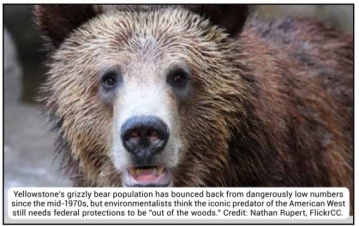
It depends who you ask. The majority of environmental and wildlife advocates would prefer to keep endangered species protections in place for Yellowstone’s grizzlies, which they consider to be still at risk. Meanwhile, many ranchers, hunters and libertarians applaud the Trump administration’s decision to take the fearsome predator off the list. But why now? According to the National Park Service (NPS), some 690 grizzly bears now roam the
greater Yellowstone ecosystem - up from only 136 or so bears in 1975. “The number of females producing cubs in the park has remained relatively stable since 1996, suggesting that the park may be at or near ecological carrying capacity for grizzly bears,” reports NPS.Secretary of the Interior Ryan Zinke considers the delisting decision “very good news for many communities and advocates in the Yellowstone region” and “the culmination of decades of hard work and dedication on the part of state, tribal, federal and private partners.”
But the non-profit Center for Biological Diversity (CBD) counters that while grizzly bear numbers in the Greater Yellowstone area may have improved since the animals were first protected in 1975, the bears continue to be isolated from other ened by recent increases in human grizzly populations and are threat- caused mortality. Meanwhile, climate change and invasive species have taken a huge toll on two of the bears’ primary food sources, WhiteBark Pine seeds and Cutthroat Trout, prompting the bears to prey on livestock outside national park borders, leading to increased conflict with livestock ranchers. CBD maintains that drought and climate change are likely to worsen these problems.
Recent scientific data showing a decline in the bears’ population over aged kills” due to livestock conflict, the past two years as a result of “man- car crashes and poaching support CBD’s claims. The group’s senior attorney, Andrea Santarsiere, says that the Trump administration’s real reason for pushing the delisting is more about appeasing trophy hunters “who want to stick grizzly bear heads on their walls” than about concern over the health of iconic American wildlife populations.
“This outrageously irresponsible decision ignores the best available science,” says Santarsiere. “Grizzly conservation has made significant strides, but the work to restore these beautiful bears has a long way to go.” Overall, grizzlies now occupy less than four percent of their historic U.S. range. European settlement led to the decimation of some 50,000 grizzlies that once roamed the western half of the Lower 48.
“It’s incredibly disturbing to see the Trump administration end protections for these beloved Yellowstone bears even as their numbers are falling,” says Santarsiere. “This deeply misguided decision just isn´t supported by the science, so the Trump administration may be leaving itself vulnerable to a strong legal challenge.”
While the Trump administration has not made any noise to date about delisting the other major population of grizzlies in the lower 48 in and around Montana’s Glacier National Park, environmentalists worry that it’s only a matter of time given the relative population stability there too.
CONTACTS: NPS Grizzly Bear Ecology, www.nps. gov/yell/learn/nature/gbearinfo.htm; Center for Biological Diversity, www.biologicaldiversity.org. EarthTalk is produced by Roddy Scheer & Doug Moss and is a registered trademark of the nonprofit Earth Action Network. To donate, visit www.earthtalk.org. Send questions to: question@earthtalk.org.























